Wednesday December
11, 2002
Delphi
For Fun Newsletter #30
Wow! Has
it really been 2 months since the last newsletter? I guess
time really does fly when you're having fun. Halloween,
Thanksgiving and a successful deer season have all come and gone.
We're iced in today, so it's a good time to get caught up and let you
occasional visitors see what has been going on.
I have my new 2.4 ghz
P4 up and running - homebuilt of course. The Gigabyte GA-8IEXP
motherboard has integrated USB 2.0, and Firewire ports as well as sound and
networking and onboard RAID so my hard drive is now mirrored for reliability.
Add an ATI Radeon 7500 video card, 512mb of DDR memory, and an extra 40gb
drive to go with one I had and it makes a decent system for $600. To
be honest, the old Celeron 800 was perfectly adequate - but once in
while action is required just so you can start spending your spare
time thinking about something else.
We passed 30,000 home
page visitors this week and are averaging about 1000 total website hits per
day, mostly search engine referrals to specific topic pages.
I added a "Top Downloads" link from the home page a few
weeks ago - it's updated weekly and shows a total of about 90,000
downloads in the past 12 months! Thanks for all of your feedback
this past year - it has encouraged me to continue the site for another
year.
Here's
wishing all a Happy Holiday Season!
And
may you and the stock market both have better times in the coming year!
Here
are the "What's New" items
since last time:
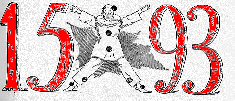 October 8: 2002: Here's another little
program which solves a puzzle from English recreational mathematician and
puzzlist Henry Ernest Dudeney. Find all sets of four
digits, [a,b,c,d], which when formed into two numbers,
(a, bcd or ab, cd), have the property that the product contains the
same four digits. I copied Dudeney's naming and called this
program
Pierrot's Puzzle. If you
know who or what a Pierrot is, you are probably either European or into
theater.
October 8: 2002: Here's another little
program which solves a puzzle from English recreational mathematician and
puzzlist Henry Ernest Dudeney. Find all sets of four
digits, [a,b,c,d], which when formed into two numbers,
(a, bcd or ab, cd), have the property that the product contains the
same four digits. I copied Dudeney's naming and called this
program
Pierrot's Puzzle. If you
know who or what a Pierrot is, you are probably either European or into
theater.
 October 17, 2002: One more Dudeney gem before
we move on. 100 years ago, puzzleist H. E. Dudeney came up with
a way to dissect a square into 4 polygons which can be reassembled to form
an equilateral triangle.
Dudeney's Dissection lets
you print outlines or partially solved solutions to work on for yourself.
October 17, 2002: One more Dudeney gem before
we move on. 100 years ago, puzzleist H. E. Dudeney came up with
a way to dissect a square into 4 polygons which can be reassembled to form
an equilateral triangle.
Dudeney's Dissection lets
you print outlines or partially solved solutions to work on for yourself.
My first attempt, shown here, is not quite up
to the job - the triangle formed is isosceles, but not equilateral.
The real solution is not quite so symmetrical.
Guess I'd better go get all these paper clippings cleaned up
before somebody comes along and delivers more comments about acting my age.
October 20, 2002: Here's a little program that
lists the largest files on a user selected drive. I just discovered
and deleted 30 mb of disk space in Outlook Express mailbox files left over
from a conversion to Outlook several months ago. Now if I can just
figure where that other gigabyte or so of hard drive bloat came from.
List Large Files is
available for downloading from a new Utilities programs section
October 26, 2002:
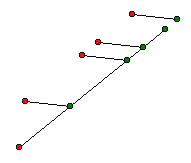
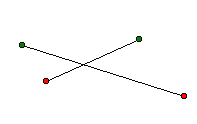
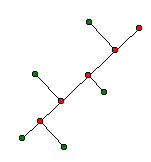
A little exercise in
Computational Geometry
was posted in the Delphi Techniques section the other day.
Included are an improved function testing for line intersection,
and functions to construct a perpendicular from a point to a line and to
construct a line through a point on a line at a given angle.
I developed them for use in Dudeney's Dissection program, but
it seems like they may be handy for any problems which combine computer
programming and geometry.
October 30, 2002: Here's today's problem
and the Expressions 2002 program that solves it:
Insert +(addition)
and × (multiplication) operators as
required into the string of digits 123456789 to form an expression that
evaluates to 2002. For example, if the desired value were 100,
then one solution would be 12+34+5×6+7+8+9=100.
This program was prompted by a viewer request. It is
similar to the Expressions100
program which required + and - operators. The
complication this time is that multiplications must be performed before
additions. The same viewer also posed a much tougher version
that's providing more hours of fun - stay tuned.
November 7, 2002:

Whew! Here is the
Discrete Event Simulator program -
one of those programs written several years ago that only needed "a
little tweaking" to get it ready to post. That was two weeks ago and
has occupied most of my spare time since then. It
simulates "transaction" processing systems that support queuing, including
many of our daily activities from the toll booth to the grocery store to
the gas station, barbershop, and public restroom, just to name a few.
A big complex topic that I think can be fun to play with, even if you are
not a grad student or professor of Mathematics. Included
are several sample cases to give you the idea, and some simple
animation that lets you watch the little customers move through the system.
 November 16, 2002: I posted a new version
of our most popular program, the
Roller Coaster Simulator today. It includes a few fixes and
enhancements. I've been working with a young man this week who
is using the program as the basis for his 6th grade Science Fair
project. Brendan's great idea is to compare G forces for circular vs.
clothoid loops. (Clothoid loops are elongated vertically and
reduce maximum G force on riders by taking the cart in a flatter
curve when it is going fastest at the bottom of the loop and
more sharply at the top when it's speed is
slowest.) I added G and Distance
columns to the Debug tab data display to help him along a
little. While playing with the program, I decided to
improve the accuracy when inserting additional control points into a
track (right click the track to enter design mode and drag, insert, or
delete control points).
November 16, 2002: I posted a new version
of our most popular program, the
Roller Coaster Simulator today. It includes a few fixes and
enhancements. I've been working with a young man this week who
is using the program as the basis for his 6th grade Science Fair
project. Brendan's great idea is to compare G forces for circular vs.
clothoid loops. (Clothoid loops are elongated vertically and
reduce maximum G force on riders by taking the cart in a flatter
curve when it is going fastest at the bottom of the loop and
more sharply at the top when it's speed is
slowest.) I added G and Distance
columns to the Debug tab data display to help him along a
little. While playing with the program, I decided to
improve the accuracy when inserting additional control points into a
track (right click the track to enter design mode and drag, insert, or
delete control points).
 November 19, 2002: It's been a while since we posted a
real beginner's program. Here's one that solves a puzzle about the
size of Mr. MacGregor's Cabbage Patch.
About 5 lines of code solve the problem and twenty lines display the results.
About normal I guess, 20% doing it and 80% talking about it.
November 19, 2002: It's been a while since we posted a
real beginner's program. Here's one that solves a puzzle about the
size of Mr. MacGregor's Cabbage Patch.
About 5 lines of code solve the problem and twenty lines display the results.
About normal I guess, 20% doing it and 80% talking about it.
November 20, 2002: Version 2 of GridQuickSort is available
over in the Delphi Techniques section. A user requested the ability
to sort integer fields. This new demo version adds a "data
type" field to QuickSort permitting columns with alpha, integer
or real data to be sorted.
Deer hunting season is upon us (at least here in Virginia),
so email is slightly backed up. If you sent feedback and requested
contact, be patient, I'll get there. Two are in the
freezer so far (deer, not emails), so the pressure is off - we'll eat well for the next
year. But the hours spent communing with nature are
restorative, so I'm still going out - just not so much at 5:30 AM, or
in the rain, or when the temperature is in the 20's or when the wind is
howling. :>)
Elizabeth - the reply-to address on your feedback is
invalid, Here's a link to the "Geometry
Junkyard" which may provide what you need. If not, please
write again.
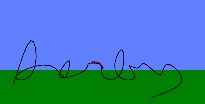 November 21, 2002: A young friend sent
this "Darby Coaster"
the other day as thanks for helping him a little with his Science Fair
project. Actually, he helped me by finding a couple of bugs in the
program, The coaster is cool but I believe I'll pass on
riding the real thing! Clicking above will download the
coaster - but if you want to see it run and don't have the program
yet, it's available from the Roller
Coaster Simulator page.
November 21, 2002: A young friend sent
this "Darby Coaster"
the other day as thanks for helping him a little with his Science Fair
project. Actually, he helped me by finding a couple of bugs in the
program, The coaster is cool but I believe I'll pass on
riding the real thing! Clicking above will download the
coaster - but if you want to see it run and don't have the program
yet, it's available from the Roller
Coaster Simulator page.
Have you ever taken
so long to find an answer that by the time you've found it, you've
forgotten the original question? That's the case with today's Set Partitions page and
program over the the Math Topics section. I'm sure I started
the investigation in order to help solve some puzzle, but it became a
fascinating study on its own. A set partition is simply a
division of a set of distinct things into subsets. Generating and
counting them involves a couple more of those numbers with guy's names
attached.
 |
| A 5x5 board that can be
solved in 4 moves* |
November 24, 2002: Here is an update to the Token Flip program - a game whose
objective is to make all tokens white by clicking. Each token
clicked will change the color of that token and those above, below, left
and right - if they exist. A viewer had requested boards
larger than the original 4x 4. This version allows boards up to 7x7.
however the "Auto solve" time gets very large very
fast. Some modifications allow this version to solve 5x5 puzzles in
a few minutes. A general 6x6 game, say one
needing 12 moves to solve, would probably take years even on a
fast computer. We really need heuristics to allow trial moves to be
selected intelligently. I've added a button that will allow
random boards with few moves to be generated. If anyone out he there
can figure out how to consistently manually solve say a 5x5 game
requiring 8 or more moves in the minimum number of moves - let me
know your "rules" for determining how to move. *(Col
4, Row 1),(C3,R2),(C4,R2),(C4,R4)
November 25, 2002: The two of us will each
take a 52-card deck, shuffle it thoroughly and place our decks face down on
the table. Now we'll start turning cards face up, one from the top of
each deck on each turn. If we go through the entire deck without two
identical cards being turned, player A wins. If an identical pair is
turned, player B wins. Do you want to be player A or
B?
Some knowledge of the mathematics of Derangements
may help you choose.
We're off to a daughter's house to eat some turkey and all that
goes with it for the next few days. If you live in a country that
celebrates Thanksgiving, have a good one. If you live elsewhere, find
something to be thankful for anyway, just on general
principle. See you in December!
| 13 |
15 |
11 |
5 |
| 14 |
16 |
12 |
6 |
| 11 |
13 |
9 |
3 |
| 10 |
12 |
8 |
2 |
December 4, 2002: Another Martin Gardner trick
this week - select one number form each row and column of the Magic Matrix. The sum will always
be the same! (The big 40 for the sample at
right.) This program will not only generate magic matrices for you, but let
you play them and understand why they work.
|
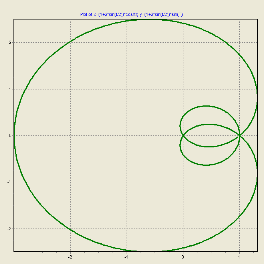
|
|
Freeth's Nephroid |
December 6, 2002: I was browsing Virginia's
SOL (Standards of Learning) guidelines the other day and was surprised to
see that the Algebra I section has a dozen or so objectives that
specifically require the use of a graphic calculator.
That prompted me to revisit our SciGraph function graphing
program and, of course, ended up fixing a few bugs and making a few
enhancements. Version 1.1 includes help pages with guidelines
for writing expressions and previously undocumented navigation
tips. The mouse can be used to zoom a rectangular area of the chart
and to display numeric values of clicked points. Users are now prompted
to save any unsaved chart changes when closing or loading a new
chart. Obviously (to me) a better choice than a
calculator for exploring graphs of functions. Maybe if I
included the "Conchoid of Nicomedes", the "Limacon of
Pascal", and the "Witch of Agnesi" curves. Love
those names!
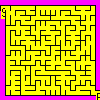 December
7, 2002: A viewer was having trouble saving mazes created with
our Maze Generator program. No
wonder - requests that did not include the .maz file
extension were just ignored. That was rather rude,
but it is fixed now. Who can find the next bug?
December
7, 2002: A viewer was having trouble saving mazes created with
our Maze Generator program. No
wonder - requests that did not include the .maz file
extension were just ignored. That was rather rude,
but it is fixed now. Who can find the next bug?
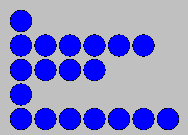 |
|
Select 1 or more from any row |
December 10, 2002: Here is a new version of
our multi-pile NIM program.
It's a good news-bad news story. The bad news is, that I didn't
realize until finished that I had written an earlier version in
April! This growing old business is going to be heck. The
good news is that at least this version has several new features including ¤
token selection by mouse clicks, ¤ computer vs. human
play, ¤ miseré (last token loses) play, and ¤
improved (.i.e. shorter) implementation of the move selection logic using
exclusive or (XOR) operations.
Gary Darby
http://www.delphiforfun.org
"Success
in solving the problem depends on choosing the right aspect, on attacking the
fortress from its accessible side." - George Polya
"Great
people are great because they solve countless, seemingly unsolvable problems;
you can too if you choose to." - Mark Victor Hansen
"Once
you have a clear objective, think and talk only in terms of 'How?'" - Brian
Tracy
To subscribe or
unsubscribe from this newsletter, visit http://delphiforfun.org/newsletter.htm
30,050 home page
visitors!
 October 8: 2002: Here's another little
program which solves a puzzle from English recreational mathematician and
puzzlist Henry Ernest Dudeney. Find all sets of four
digits, [a,b,c,d], which when formed into two numbers,
(a, bcd or ab, cd), have the property that the product contains the
same four digits. I copied Dudeney's naming and called this
program
Pierrot's Puzzle. If you
know who or what a Pierrot is, you are probably either European or into
theater.
October 8: 2002: Here's another little
program which solves a puzzle from English recreational mathematician and
puzzlist Henry Ernest Dudeney. Find all sets of four
digits, [a,b,c,d], which when formed into two numbers,
(a, bcd or ab, cd), have the property that the product contains the
same four digits. I copied Dudeney's naming and called this
program
Pierrot's Puzzle. If you
know who or what a Pierrot is, you are probably either European or into
theater.  October 17, 2002: One more Dudeney gem before
we move on. 100 years ago, puzzleist H. E. Dudeney came up with
a way to dissect a square into 4 polygons which can be reassembled to form
an equilateral triangle.
October 17, 2002: One more Dudeney gem before
we move on. 100 years ago, puzzleist H. E. Dudeney came up with
a way to dissect a square into 4 polygons which can be reassembled to form
an equilateral triangle.




 November 16, 2002: I posted a new version
of our most popular program, the
November 16, 2002: I posted a new version
of our most popular program, the November 19, 2002: It's been a while since we posted a
real beginner's program. Here's one that solves a puzzle about the
size of Mr.
November 19, 2002: It's been a while since we posted a
real beginner's program. Here's one that solves a puzzle about the
size of Mr.  November 21, 2002: A young friend sent
this "
November 21, 2002: A young friend sent
this "

 December
7, 2002: A viewer was having trouble saving mazes created with
our
December
7, 2002: A viewer was having trouble saving mazes created with
our 